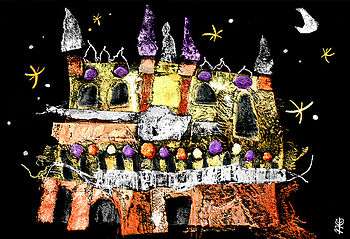Carborundum printmaking

Carborundum printmaking is a collagraph printmaking technique in which the image is created by adding light passages to a dark field. It is a relatively new process invented in the US during the 1930s that allows artists to work on a large scale. Normally, cardboard or wood plates are coated in a layer of carborundum or screen, and the lights are created by filling in the texture with screen filler or glue. Carborundum prints may be printed as intaglio plates.
Carborundum was originally used by printmakers to grind down lithography stones and is now used in collagraph prints to create gradients of tone and a sandy texture. It works because when the carborundum adheres to the plate the ink sits around it. It can be applied in a number of different ways:
- Painting onto the plate with a liquid glue and then sprinkling the carborundum onto it
- Mixing different amounts of glue with it and then painting them on in sections, the more grit used the darker. Example: one spoon of carborundum to five spoons of glue will be much lighter than five spoons of carborundum to five spoons of glue.
- Using stencils to apply the glue and sprinkling different amounts of carborundum through the different stencils.
To print a carborundum print, the surface is covered in ink, and then the surface is wiped clean with tarlatan cloth or newspaper, leaving ink only in the texture of the screen or carborundum. A damp piece of paper is placed on top, and the plate and paper are run through a printing press that, through pressure, transfers the ink from the recesses of the plate to the paper. Very large editions are not possible as a small amount of carborundum comes off every time it is wiped down.[1]
Uses
Contrast with relief printing, and with planographic printing techniques such as lithography.
References
- ↑ "Exhibition reviews" (PDF). Retrieved 2009-06-06.
See also
| Look up intaglio in Wiktionary, the free dictionary. |